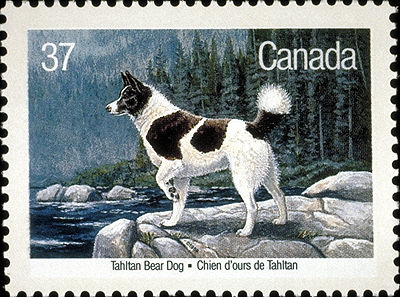Browse "Nature & Geography"
-
Article
Tahltan Bear Dog
The Tahltan (pronounced tall-tan) bear dog was one of five dog breeds recognized by the Canadian Kennel Club as uniquely Canadian (see also Dogs in Canada). Although the name of the breed suggests it was only kept by the Tahltan Nation of Northwestern British Columbia, the dog was common among other First Nations in the region, too. These included the Tlingit, Tagish, Kaska and Sekani. The Tahltan people referred to it as “our dog,” which gave the breed its name. Indigenous peoples used the Tahltan bear dog in sustenance hunting— primarily for bear— an activity in which it excelled. The breed went extinct in the in the 1970s or 80s.
"https://d2ttikhf7xbzbs.cloudfront.net/media/media/5e996c76-2f62-4622-b889-20d4eebc2518.jpg" // resources/views/front/categories/view.blade.php
https://d2ttikhf7xbzbs.cloudfront.net/media/media/5e996c76-2f62-4622-b889-20d4eebc2518.jpg
-
Article
Tanager
The tanager (Thraupidae) is a family of small songbirds, possibly comprising as many as 413 species.
"https://development.thecanadianencyclopedia.ca/images/tce_placeholder.jpg?v=e9dca980c9bdb3aa11e832e7ea94f5d9" // resources/views/front/categories/view.blade.php
https://development.thecanadianencyclopedia.ca/images/tce_placeholder.jpg?v=e9dca980c9bdb3aa11e832e7ea94f5d9
-
Article
Tantramar Marsh
The Tantramar marsh is one of four saltwater tidal marshes covering 20,230 ha on the narrow Chignecto Isthmus that connects New Brunswick and Nova Scotia.
"https://development.thecanadianencyclopedia.ca/images/tce_placeholder.jpg?v=e9dca980c9bdb3aa11e832e7ea94f5d9" // resources/views/front/categories/view.blade.php
https://development.thecanadianencyclopedia.ca/images/tce_placeholder.jpg?v=e9dca980c9bdb3aa11e832e7ea94f5d9
-
Article
Termite
Termites are social insects of the infraorder Isoptera. They may be thought of as “social cockroaches,” as they evolved from their wood-eating cockroach ancestors approximately 200 million years ago.
"https://d2ttikhf7xbzbs.cloudfront.net/media/media/4be4a60c-706f-461e-864a-8092a1f88036.jpg" // resources/views/front/categories/view.blade.php
https://d2ttikhf7xbzbs.cloudfront.net/media/media/4be4a60c-706f-461e-864a-8092a1f88036.jpg
-
Article
Tern
The tern is a medium-sized bird of the GULL family. Terns are usually grey and white; in spring and summer most species have a black cap. Similar to gulls in appearance, terns differ in having more pointed wings and usually a noticeably forked tail.
"https://d2ttikhf7xbzbs.cloudfront.net/media/media/8f13f204-5e6c-43ad-8818-c33be4752a8d.jpg" // resources/views/front/categories/view.blade.php
https://d2ttikhf7xbzbs.cloudfront.net/media/media/8f13f204-5e6c-43ad-8818-c33be4752a8d.jpg
-
Article
Montréal Biodôme
Opened in 1992 and located in the former Olympic velodrome, the Montréal Biodôme is part of the “Space for Life” network, which includes Montréal’s Insectarium, Planetarium and Botanical Garden.
"https://d2ttikhf7xbzbs.cloudfront.net/media/media/602331f5-435c-42b0-848e-0be2945dce57.jpg" // resources/views/front/categories/view.blade.php
https://d2ttikhf7xbzbs.cloudfront.net/media/media/602331f5-435c-42b0-848e-0be2945dce57.jpg
-
Article
Thistle
The thistle (Carduaceae tribe, family Compositae or Asteraceae) is a spiny herbaceous plant with white or purple flowers. There are 800 species worldwide, 46 in Canada (15 native). Native species (none serious WEEDS) are mainly "true" or "plumed" thistles of genus Cirsium.
"https://development.thecanadianencyclopedia.ca/images/tce_placeholder.jpg?v=e9dca980c9bdb3aa11e832e7ea94f5d9" // resources/views/front/categories/view.blade.php
https://development.thecanadianencyclopedia.ca/images/tce_placeholder.jpg?v=e9dca980c9bdb3aa11e832e7ea94f5d9
-
Article
Thrasher
Thrashers (Mimidae) are a small family of slender, long-tailed, medium-sized, insectivorous and frugivorous birds with loud, musical, repetitive songs.
"https://d2ttikhf7xbzbs.cloudfront.net/media/media/0b04d7e6-d80a-4290-8760-e575afc17c1b.jpg" // resources/views/front/categories/view.blade.php
https://d2ttikhf7xbzbs.cloudfront.net/media/media/0b04d7e6-d80a-4290-8760-e575afc17c1b.jpg
-
Article
Thrips
Thrips, order Thysanoptera (Gk for "fringe-wings"), are among the smallest insects, being slender and usually less than 2 mm long.
"https://development.thecanadianencyclopedia.ca/images/tce_placeholder.jpg?v=e9dca980c9bdb3aa11e832e7ea94f5d9" // resources/views/front/categories/view.blade.php
https://development.thecanadianencyclopedia.ca/images/tce_placeholder.jpg?v=e9dca980c9bdb3aa11e832e7ea94f5d9
-
Article
Thrush
Thrushes (Muscicapidae) are a very large family comprising about 450 species of small passerines (perching birds) ranging 11-33 cm in length.
"https://development.thecanadianencyclopedia.ca/images/tce_placeholder.jpg?v=e9dca980c9bdb3aa11e832e7ea94f5d9" // resources/views/front/categories/view.blade.php
https://development.thecanadianencyclopedia.ca/images/tce_placeholder.jpg?v=e9dca980c9bdb3aa11e832e7ea94f5d9
-
Article
Thunderstorm
Thunderstorms usually occur on summer afternoons. While a thunderstorm typically affects a given locality for only an hour or so during its passage overhead, the entire lifetime may be as long as 6-10 hours, along a pathway of several hundred kilometres.
"https://development.thecanadianencyclopedia.ca/images/tce_placeholder.jpg?v=e9dca980c9bdb3aa11e832e7ea94f5d9" // resources/views/front/categories/view.blade.php
https://development.thecanadianencyclopedia.ca/images/tce_placeholder.jpg?v=e9dca980c9bdb3aa11e832e7ea94f5d9
-
Article
Tick
Ticks are small, bloodsucking arachnids that live as external parasites on terrestrial mammals, birds, amphibians and reptiles. Ticks belong to the order Ixodida, a group of parasitic mites in the superorder Parasitiformes. This superorder also includes the varroa mite, a destructive parasite of honeybees. About 900 tick species are known worldwide, of which 48 have been found in Canada. Although they are most diverse in tropical regions, ticks continue to be significant pests to humans and other mammals as far north as the Canadian tundra.
"https://d2ttikhf7xbzbs.cloudfront.net/tick/Female-Black-Legged-Tick-on-Leaf.jpg" // resources/views/front/categories/view.blade.php
https://d2ttikhf7xbzbs.cloudfront.net/tick/Female-Black-Legged-Tick-on-Leaf.jpg
-
Article
Tidal Energy
Tidal energy is a largely untapped, renewable energy source based largely on lunar gravitation. While the potential of tidal hydroelectricity has long been recognized, compared to river dams, tidal power projects are expensive because massive structures must be built in difficult saltwater environments.
"https://d2ttikhf7xbzbs.cloudfront.net/media/media/20ec66d0-4579-4f2a-942d-5bb87ded61be.jpg" // resources/views/front/categories/view.blade.php
https://d2ttikhf7xbzbs.cloudfront.net/media/media/20ec66d0-4579-4f2a-942d-5bb87ded61be.jpg
-
Article
Tide
The Earth is actually not in orbit around the sun but around the centre of mass of the Earth-sun system. Since all parts of the Earth move in the same orbit, they experience the same acceleration, but only at the Earth's centre is this acceleration exactly balanced by the sun's gravitation.
"https://d2ttikhf7xbzbs.cloudfront.net/media/media/989a9feb-532c-452f-829d-b5fecf83d434.jpg" // resources/views/front/categories/view.blade.php
https://d2ttikhf7xbzbs.cloudfront.net/media/media/989a9feb-532c-452f-829d-b5fecf83d434.jpg
-
Article
Tiktaalik
Tiktaalik is a genus of lobe-finned (sarcopterygian) fish from the Devonian Period found on Ellesmere Island, Nunavut, in Canada’s Arctic Archipelago. A single species is known of Tiktaalik, T. roseae, which lived approximately 385 million years ago. The species was named in 2006 in two articles that described several articulated specimens. These articles set off a storm in the popular press. Titkaalik represents a clear and important evolutionary step in the journey of animals onto land.
"https://d2ttikhf7xbzbs.cloudfront.net/tiktaalik/Tiktaalik-Model.jpg" // resources/views/front/categories/view.blade.php
https://d2ttikhf7xbzbs.cloudfront.net/tiktaalik/Tiktaalik-Model.jpg
